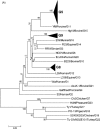Detection and genotyping of Korean porcine rotaviruses
- PMID: 20359834
- PMCID: PMC7117351
- DOI: 10.1016/j.vetmic.2010.01.019
Detection and genotyping of Korean porcine rotaviruses
Abstract
Porcine group A rotavirus (GARV) is considered to be an important animal pathogen due to their economic impact in the swine industry and its potential to cause heterologous infections in humans. This study examined 475 fecal samples from 143 farms located in 6 provinces across South Korea. RT-PCR and nested PCR utilizing primer pairs specific for the GARV VP6 gene detected GARV-positive reactions in 182 (38.3%) diarrheic fecal samples. A total of 98 porcine GARV strains isolated from the GARV-positive feces were analyzed for G and P genotyping. Based on the sequence and phylogenetic analyses, the most predominant combination of G and P genotypes was G5P[7], found in 63 GARV strains (64.3%). The other combinations of G and P genotypes were G8P[7] (16 strains [16.3%]), G9P[7] (7 strains [7.1%]), G9P[23] (2 strains [2.0%]), and G8P[1] (1 strain [1.0%]). The counterparts of G or P genotypes were not determined in three G5, five P[7], and one P[1] strains. Interestingly, phylogenetic analysis indicated that all Korean G9 strains were more closely related to lineage VI porcine and human viruses than to other lineages (I-V) of GARVs and to Korean human G9 strains (lineage III). These results show that porcine GARV infections are common in diarrheic piglets in South Korea. The infecting strains are genetically diverse, and include homologous (G5P[7]), heterologous (G8P[1]), and reassortant (G8P[7]), as well as emerging G9 GARV strains.
Copyright 2010 Elsevier B.V. All rights reserved.
Figures



Similar articles
-
Genetic diversity and novel combinations of G4P[19] and G9P[19] porcine rotavirus strains in Thailand.Vet Microbiol. 2013 Jan 25;161(3-4):255-62. doi: 10.1016/j.vetmic.2012.07.036. Epub 2012 Jul 27. Vet Microbiol. 2013. PMID: 22884282
-
Detection and characterisation of group A rotavirus in asymptomatic piglets in southern Ireland.Arch Virol. 2010 Aug;155(8):1247-59. doi: 10.1007/s00705-010-0713-1. Epub 2010 Jun 6. Arch Virol. 2010. PMID: 20526785
-
[Evolutionary relationships of G3 GARV isolated from pigs and humans in Lulong County, Hebei Province, China].Bing Du Xue Bao. 2014 Jul;30(4):417-22. Bing Du Xue Bao. 2014. PMID: 25272597 Chinese.
-
Porcine group A rotaviruses with heterogeneous VP7 and VP4 genotype combinations can be found together with enteric bacteria on Belgian swine farms.Vet Microbiol. 2014 Aug 6;172(1-2):23-34. doi: 10.1016/j.vetmic.2014.04.002. Epub 2014 Apr 13. Vet Microbiol. 2014. PMID: 24837191 Review.
-
Review of group A rotavirus strains reported in swine and cattle.Vet Microbiol. 2013 Aug 30;165(3-4):190-9. doi: 10.1016/j.vetmic.2013.03.020. Epub 2013 Apr 4. Vet Microbiol. 2013. PMID: 23642647 Free PMC article. Review.
Cited by
-
Prevalence and genotypic (G and P) determination of porcine group A rotaviruses from different regions of India.Trop Anim Health Prod. 2013 Feb;45(2):609-15. doi: 10.1007/s11250-012-0267-1. Epub 2012 Sep 26. Trop Anim Health Prod. 2013. PMID: 23011672
-
Prevalence and genomic characterization of rotavirus group A genotypes in piglets from southern highlands and eastern Tanzania.Heliyon. 2022 Nov 23;8(11):e11750. doi: 10.1016/j.heliyon.2022.e11750. eCollection 2022 Nov. Heliyon. 2022. PMID: 36468104 Free PMC article.
-
Occurrence and molecular characterization of Sapelovirus A in diarrhea and non-diarrhea feces of different age group pigs in one Korean pig farm.J Vet Med Sci. 2017 Jan 10;78(12):1911-1914. doi: 10.1292/jvms.16-0237. Epub 2016 Sep 11. J Vet Med Sci. 2017. PMID: 27616554 Free PMC article.
-
Predominance of porcine P[23] genotype rotaviruses in piglets with diarrhea in northern Thailand.J Clin Microbiol. 2011 Jan;49(1):442-5. doi: 10.1128/JCM.02263-10. Epub 2010 Nov 17. J Clin Microbiol. 2011. PMID: 21084504 Free PMC article.
-
Different virulence of porcine and porcine-like bovine rotavirus strains with genetically nearly identical genomes in piglets and calves.Vet Res. 2013 Oct 1;44(1):88. doi: 10.1186/1297-9716-44-88. Vet Res. 2013. PMID: 24083947 Free PMC article.
References
-
- Abe M., Ito N., Morikawa S., Takasu M., Murase T., Kawashima T., Kawai Y., Kohara J., Sugiyama M. Molecular epidemiology of rotaviruses among healthy calves in Japan: isolation of a novel rotavirus bearing new P and G genotypes. Virus Res. 2009;144:250–257. - PubMed
-
- Alfieri A.F., Alfieri A.A., Barreiros M.A., Leite J.P., Richtzenhain L.J. G and P genotypes of group A rotavirus strains circulating in calves in Brazil, 1996–1999. Vet. Microbiol. 2004;99:167–173. - PubMed
Publication types
MeSH terms
Substances
LinkOut - more resources
Full Text Sources
Medical

